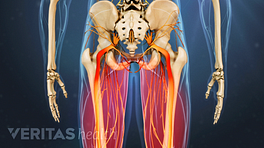An isthmic spondylolisthesis may also become symptomatic in adults, most typically when people are in their 30s and 40s.
How Spondylolisthesis Causes Pain
There are two primary forces at work with isthmic spondylolisthesis in adults.
Disc Degeneration
The most common reason for low back pain in this situation is that the disc will start to wear out. Without a posterior tether connecting the facet joints, the disc space is forced to withstand shear forces. Normally the facet joints in the back of the spine protect the disc from shear as they act to limit the shear force. When there is a pars interarticularis fracture the facet joints cannot limit shear. Discs work well as a shock absorber but they are susceptible to being damaged if they have to resist shear. The associated cumulative stress leads the disc to breakdown and eventually become painful.
See What Is Degenerative Disc Disease?
Nerve Pinching
As the discs break down, they become flatter and the disc provides less room for the nerve root to exit the spine (e.g. the L5 nerve root at L5-S1 level) and the patient can develop leg pain (radiculopathy, or sciatica). It is common for the leg pain to be related to walking or standing as in these positions the foramen (the opening where the nerve exits the spine) is closed down. When sitting the foramen is larger and eliminates the pressure on the nerve. However, the converse may also be true, as in the sitting position the disc is loaded three times more than when standing, and the loaded disc can bulge into the foramen causing leg pain.







